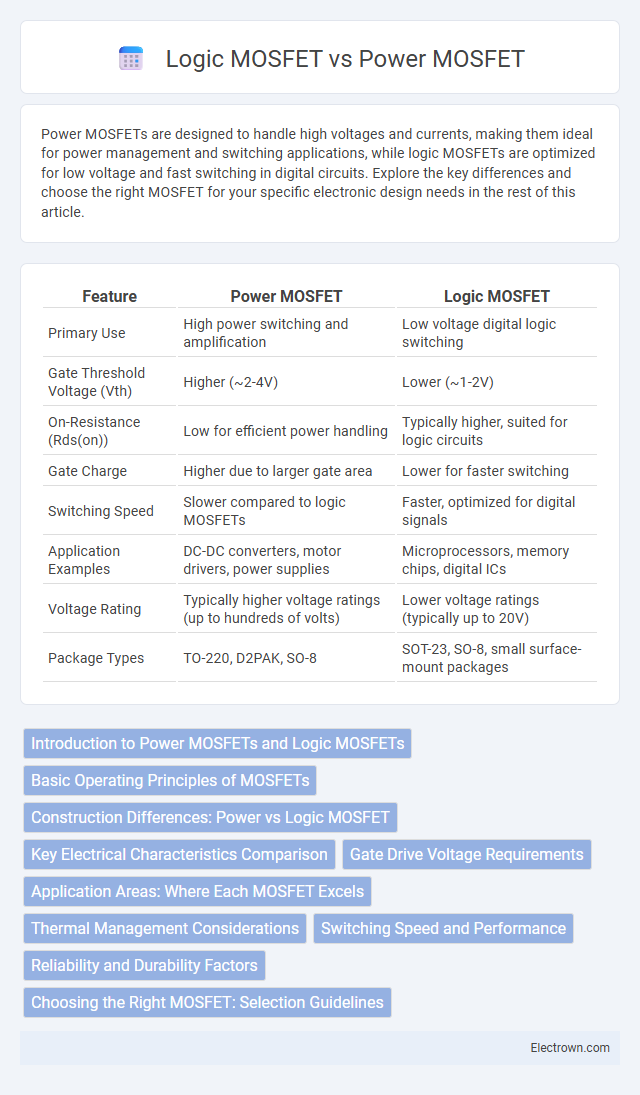Power MOSFETs are designed to handle high voltages and currents, making them ideal for power management and switching applications, while logic MOSFETs are optimized for low voltage and fast switching in digital circuits. Explore the key differences and choose the right MOSFET for your specific electronic design needs in the rest of this article.
Table of Comparison
| Feature | Power MOSFET | Logic MOSFET |
|---|---|---|
| Primary Use | High power switching and amplification | Low voltage digital logic switching |
| Gate Threshold Voltage (Vth) | Higher (~2-4V) | Lower (~1-2V) |
| On-Resistance (Rds(on)) | Low for efficient power handling | Typically higher, suited for logic circuits |
| Gate Charge | Higher due to larger gate area | Lower for faster switching |
| Switching Speed | Slower compared to logic MOSFETs | Faster, optimized for digital signals |
| Application Examples | DC-DC converters, motor drivers, power supplies | Microprocessors, memory chips, digital ICs |
| Voltage Rating | Typically higher voltage ratings (up to hundreds of volts) | Lower voltage ratings (typically up to 20V) |
| Package Types | TO-220, D2PAK, SO-8 | SOT-23, SO-8, small surface-mount packages |
Introduction to Power MOSFETs and Logic MOSFETs
Power MOSFETs are designed for high-efficiency power switching applications, featuring low on-resistance and high current handling capabilities essential for power management in devices such as DC-DC converters and motor drivers. Logic MOSFETs, on the other hand, optimize for low gate threshold voltage and fast switching at low voltages, making them ideal for digital circuits and microcontroller interfacing. Understanding the differences between Power MOSFETs and Logic MOSFETs helps you select the appropriate transistor for your specific power or logic-level switching requirements.
Basic Operating Principles of MOSFETs
Power MOSFETs operate by controlling large currents and voltages through a vertical structure, offering low on-resistance and high efficiency for power switching applications. Logic MOSFETs are designed for low voltage, low current operations with fast switching speeds, using a planar structure optimized for digital circuits. Both types rely on the formation of a conductive channel between the source and drain terminals modulated by the gate voltage to switch device states.
Construction Differences: Power vs Logic MOSFET
Power MOSFETs feature a vertical structure with a thick N- epitaxial layer to handle high voltage and current, enabling efficient power dissipation and lower on-resistance. Logic MOSFETs use a planar structure optimized for low gate charge and fast switching at low voltages, making them suitable for digital signal processing. You should consider these construction differences when selecting a MOSFET to ensure compatibility with your application's voltage, current, and switching speed requirements.
Key Electrical Characteristics Comparison
Power MOSFETs feature high current capacity, low on-resistance (R_DS(on)), and high voltage ratings ideal for power amplification and switching. Logic MOSFETs operate at lower voltages with threshold voltages compatible with digital logic levels, enabling efficient integration in microcontrollers and digital circuits. Understanding these key electrical characteristics helps you choose the right MOSFET type for your specific application needs.
Gate Drive Voltage Requirements
Power MOSFETs typically require a higher gate drive voltage, often around 10-15V, to fully switch on and minimize conduction losses, making them suitable for high-current applications. Logic MOSFETs, designed for low-voltage digital circuits, operate efficiently at lower gate voltages around 4.5-5V, allowing direct interfacing with logic-level signals from microcontrollers. The gate drive voltage requirement directly impacts switching speed, thermal performance, and overall efficiency in power management systems.
Application Areas: Where Each MOSFET Excels
Power MOSFETs excel in high-current and high-voltage applications such as power supplies, motor controllers, and automotive systems due to their low on-resistance and efficient thermal management. Logic MOSFETs are optimized for digital circuits and microprocessors where fast switching speeds and low gate charge enable efficient signal processing and logic level compatibility. Each type is tailored to its domain, with power MOSFETs dominating in power management and logic MOSFETs focusing on integrated circuit switching performance.
Thermal Management Considerations
Power MOSFETs feature lower on-resistance (R_DS(on)) and higher current handling, which generates significant heat requiring robust thermal management solutions like heat sinks and thermal vias. Logic MOSFETs typically have higher R_DS(on) and lower current ratings, resulting in less thermal dissipation, allowing for simpler cooling strategies. Effective thermal management in Power MOSFETs ensures reliability and performance in high-power applications by maintaining junction temperatures within safe operating limits.
Switching Speed and Performance
Power MOSFETs typically exhibit higher current handling capabilities but have slower switching speeds due to larger gate charge and capacitances, making them suitable for high-power applications. Logic MOSFETs offer faster switching speeds with lower gate charge and reduced input capacitance, enhancing performance in low-voltage digital circuits where rapid switching is critical. Optimizing device selection based on switching speed and efficiency is essential for balancing power delivery and performance in electronic systems.
Reliability and Durability Factors
Power MOSFETs are designed with robust structures to handle high voltage and current, ensuring superior reliability in harsh environments and demanding applications. Logic MOSFETs prioritize low gate charge and fast switching, which may limit their durability under heavy power stress compared to power MOSFETs. Your choice should consider the operating conditions, as power MOSFETs generally offer enhanced longevity and reliability for high-power applications.
Choosing the Right MOSFET: Selection Guidelines
When choosing the right MOSFET for your application, power MOSFETs are ideal for high-current, high-voltage environments due to their low on-resistance and efficient heat dissipation, making them suitable for power switching and amplification. Logic MOSFETs excel in low-voltage, low-power digital circuits because of their compatibility with standard logic-level gate drives and faster switching speeds. Consider parameters like gate threshold voltage, R_DS(on), and voltage ratings to ensure optimal performance and reliability in your electronic design.
Power MOSFET vs logic MOSFET Infographic

 electrown.com
electrown.com